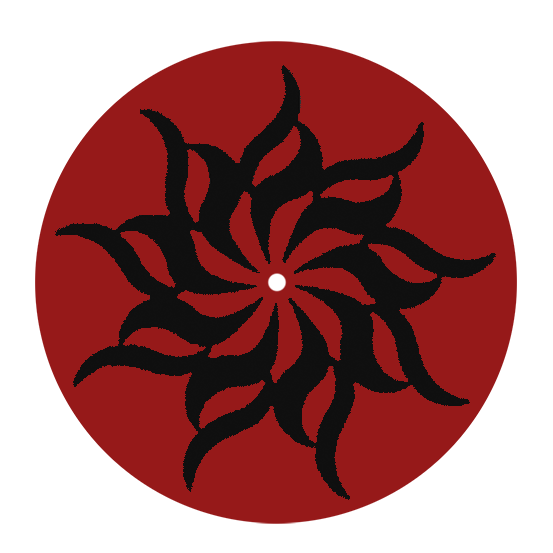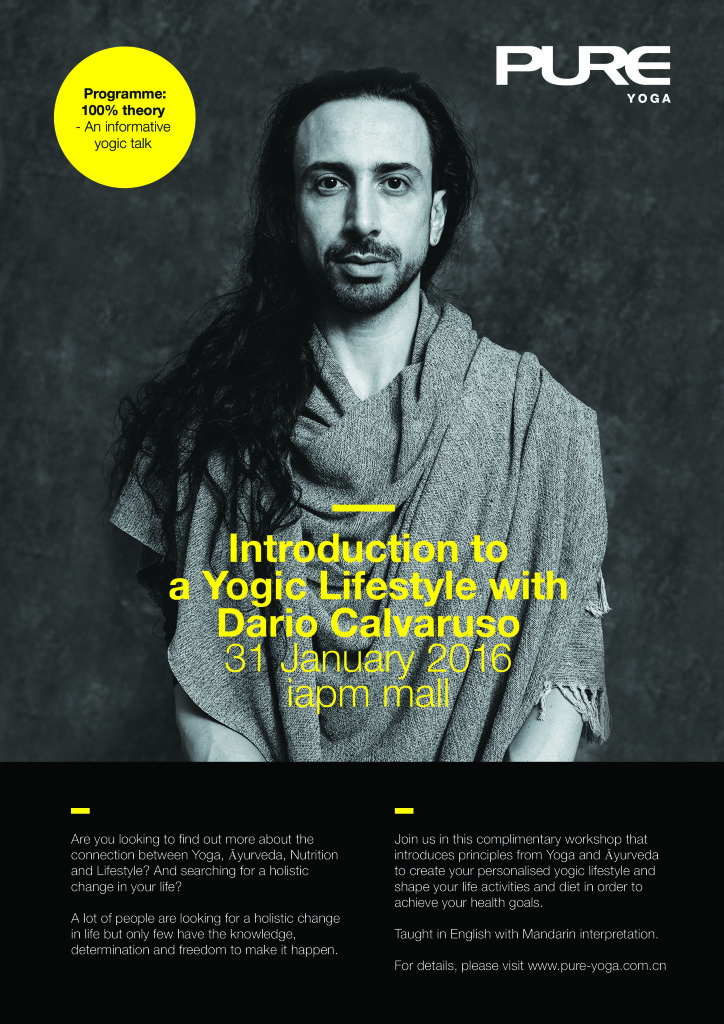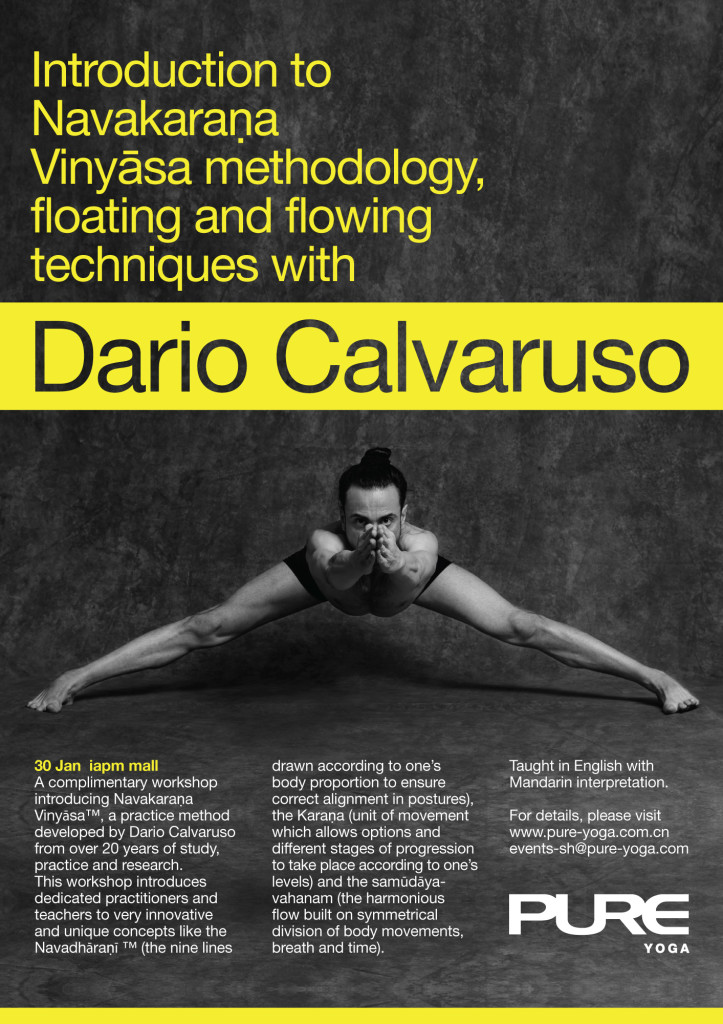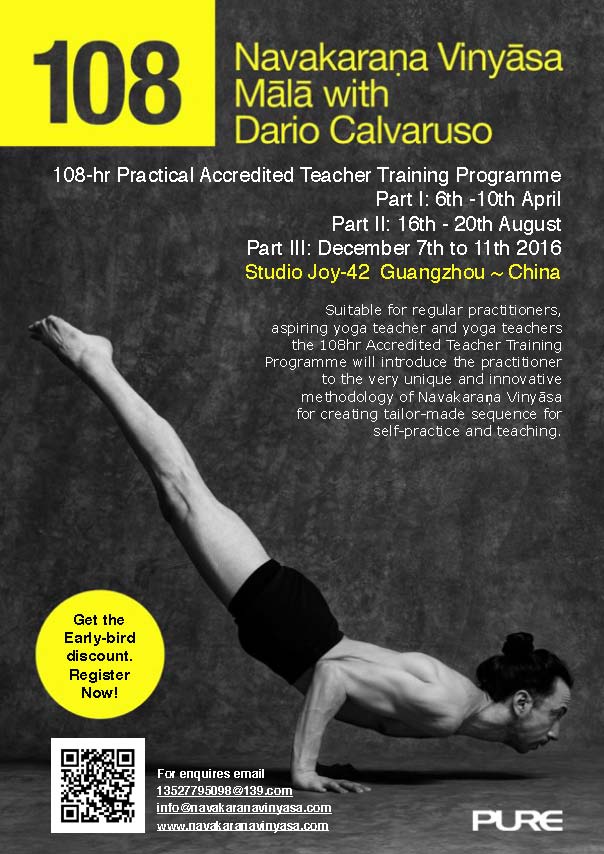Navakaraṇa Vinyāsa Glossary of Sanskrit Terms
Regularly adapted (click here).
|| नवकरण विन्यास प्रार्थना ||Navakaraṇa Vinyāsa Prārthanā – Opening Prayer
Prārthanā is a prayer as forming part of the worship of teachers and the Ultimate Being.This verse is a metre called Mālinī (मालिनी) with 15 syllables in each quarter and with a definite pattern of gaṇas (groups) of syllables named “na na am ya ya ( न न म य य )”; each gaṇa consisting of three syllables. This belongs to a category of chandas by name atiśakvarī chandas (अतिशक्वरी छन्दस्). The verse is closed (by the last word “nūnam” नूनम्) – a poetical “fancy figure of speech” or embellishment called utprekśā (उत्प्रेक्षा).
AUDIO FOR PRACTICE (15 minutes loop)
15 minutes MP4 Prārthanā (Prayer) + Svara (musical background)
The bandhas
Mūla bandha (root lock )
The contraction of the in the perineum, between the anus and the sexual organ (for males) and at the cervix, where the vagina and the uterus meet (for females) is know as mūla bandha. Do not confused mūla bandha with aśvini-mudra (contraction of the anus) or with the light pelvic floor muscles contraction of ujjāyī prāṇāyāma. Generally mūla bandha is accomplished at the end of inhalation, it is hold during inner retention and it is released during exhalation. Advance practitioners may hold the mūla bandha while breathing but with more intensity at the end of the inhalation.
Uḍḍiyāna bandha (fly upwards lock)
When the breath is hold out after a complete exhalation and the diaphragm is raised inwards and upwards a kind of vacuum and lock created in the chest. This is called uḍḍiyāna bandha. Uḍḍiyāna bandha should not be confused with the gentle withdraw of the abdomen toward the spine performed during ujjāyī prāṇāyāma. The mūla bandha and the uḍḍiyāna bandha are better performed with jālandhara bandha.
Jālandhara bandha (lit. net-stream lock or throat lock)
The firm pressure of the chin on the collarbone is know as jālandhara bandha (throat lock). The jālandhara bandha is achieved either before inner retention or outer retention. It can be hold while breathing for prolong period of time and in various āsanas. It can be combined with both mūla bandha and uḍḍiyāna bandha.
Combination of bandha-s
The mūla bandha is better achieved by performing first the jālandhara bandha during the inner retention of breath. Both locks are released with the exhalation; first the jālandhara bandha followed by the mūla bandha. The combination of jālandhara bandha and mūla bandha can be hold while breathing for prolong period of time in various āsanas with more intensity during at the end of the inhalation. The uḍḍiyāna bandha is better achieved by performing first the jālandhara bandha during the external retention of breath. The lock it is hold during the inner retation of breath; then both are released (first the uḍḍiyāna bandha followed by jālandhara bandha) before the inhalation.
Māha bandha
The combination of the three locks is called māha-bandha (lit. the great lock). It is much more effective than the three locks practiced separately. The māha-bandha is performed after a complete exhalation in the following order: the jālandhara bandha followed by the uḍḍiyāna bandha followed by the mūla bandha. The three locks are hold during external retention without straining. Then one by one is released in the opposite order (i.e. the mūla bandha, the uḍḍiyāna bandha, and only finally the jālandhara bandha).
Ujjāyī prāṇāyāma (victorious prāṇic control)
Ujjāyī prāṇāyāma is the co-regulation of the breath (ana) and the vital energies (praṇa). When the pelvic floor muscles are slightly contracted and lift up, the abdomen is slightly withdraw toward the spine, the glottis withdraw towards the back of the throat, the chest expands upward and outward (like those of a victorious hero), the tongue rolled upwards and backwards above the soft palate into the nasal cavity (khecarī mudrā) a deep hissing sound (so – सो) is produced at the thyroid level. At the end of inhalation (when the pelvic floor is more contracted and the lungs are fully filled) the exhalation starts with a whispering sound (‘ham – हम्). At the end of exhalation the the stomach is retained slightly withdraw toward the spine ready for the next inhalation. This is called ujjāyī prāṇāyāma and is the technique of prāṇic control applied in the Navakaraṇa Vinyāsa practice.
Do not confused the engagement of the three prāṇic centres (prāṇa-ādhāra-prayoga) achived through the light contraction of the the pelvic floor muscles, the gentle withdraw of the abdomen toward the spine and the contraction and withdraw of the glottis towards the back of the throat with the three locks (bandha-s: mūla bandha, uḍḍiyāna bandha and jālandhara bandha respectively). The gentle contractions required during ujjāyī prāṇāyāma occur throughout the practice. The three bandha-s occur only in specific postures and kriyās and follow different patterns. Further it is very not possible and it is harmful to try to breath during māha-bandha or uḍḍiyāna bandha.
Bhastrika (bellows)
Bhastrika is both a prāṇāyāma and a kriyā- śuddhi (active purification).
When a forceful breath is taken in through both nostrils and expelled forceful through both nostrils a clear sound is produced on the nasal passage and a sudden increase of air is provided to the lungs. The sound produced and the expansion and contraction of the lungs resemble that of the bellow hence it is called bhastrika (bellow). The process can be repeated several times. It can be combined with bandhas. In this case the breath is hold out (bahya kumbhaka – outer retention) after the last exhalation to perform maha bandha for a suitable duration of time. Bhastrika raises the inner body temperature and helps in burning toxins, opening the pranic blockages, clearing the mind from negative thoughts. Bhastrika can be practiced with the right nostril, left nostril, and both nostrils in three stages one after the other. It can also be combined with other kriyā and body movements.
Kapālabhātī (front-lobe splendour)
When a gentle breath is taken rapidly from the the nostril and exhale with a forceful contraction of the abdominal muscles is called kapālabhātī. Kapālabhātī is both a prāṇāyāma and a kriyā- śuddhi (active purification). The process is repeated for a comfortable number of times with passive inhalation. It can be combined with bandhas. It this case it is concluded with a deep and slow inhalation followed by a forceful exhalation (to empty the lungs) then the breath is hold out (bahya kumbhaka – outer retention) and the maha bandha is performed for a suitable duration of time. Kapālabhātī helps to clear the front lobe and lungs, awakes mind and senses and stimulates the digestive system.
Nāḍi śodhana (purification of the pranic channels)
When the breath is taken in slowly through the left nostril (keeping the right nostril closed.) and retained in (āntara kumbhaka – inner retention) for a comfortable period of time (by closing both nostrils and slightly contracting the glottis) and thereafter released through the right nostril (by keeping the left nostril closed) and retained out for a comfortable period of time and then followed by the reversed process is called nāḍi śodhana. The whole process can be repeated a comfortable number of times (cycles), with or without nāsāgra mudrā (right hand with the finger tips of the thumbs and ring-finger touching the nostrils), following various rhythmic pattern (ratio) of inhalation, exhalation and retention of breaths which should be learned in a 1-to-1 setting. When performed without nāsāgra mudrā is called nirālamba (self-supported) anuloma-viloma (“alternate” – lit. natural and opposite direction) nāḍi śuddhi (purification of the pranic channels) prāṇāyāma (prāṇic control). Nāḍi śodhana clears the pranic channels, helps to remove congestion, provides extra supply oxygen and helps in eliminating more efficiently carbon dioxide. It induces tranquility, clears the mind from negative thoughts and prepares for meditational practice.
Prāṇa (vital energies)
The vital energies (prāṇa) are pervasive overall the body. The vital energies (prāṇa) can be regulated through the by the engagement of three prāṇic centres (prāṇa-ādhāra-prayoga).
The three prāṇic centres are located:
- between the root of the spine and the navel; dominated the element “air”
- between the navel and the heart; dominated the element “fire”.
- and between the heart and the head; dominated the element “water”.
The main prāṇa-s are of these three sites are:
- prāṇa, udāna, samāna, vyāna, apāna;
- pācaka, rañjaka, bhrājaka, ālocaka, sādhaka;
- avalambaka, bodhaka, tarpaka, kledaka and śleṣaka.
The engagement and co-regulation of the three prāṇic centres is achieved through a particular technique of prāṇāyāma (prāṇic control) called ujjāyī (lit. victorious).
Mātrā (count)
The filling inhalation (pūraka) counted one with the inner retention (āntara kumbhaka) is the count of filling inhalation or pūraka-mātrā (viz. I,III,V, etc). The exhalation (recaka) is counted one with outer retention (bāhya kumbhaka) is the “count of exhalation” (recaka-mātrā). The “count of filling inhalation” (pūraka-mātrā) and the “count of exhalation” (recaka-mātrā) should be equal in duration and together form a complete breath (ana).
Ana (breath)
The breath cycle (ana) has 4 components (avayava-s):
- pūraka (inhalation)
- āntara kumbhaka (inner retention)
- recaka (exhalation)
- bahya kumbhaka (outer retention)
In the karaṇa the inner retention (āntara kumbhaka) and outer retention (bahya kumbhaka) are generally minimised up to the extend that are almost imperceptible and counted respectively as one with the inhalation (pūraka) and the exhalation (recaka).
Laya (the relatively constant unit of time)
The duration of the breath (ana) establishes the unit of time (laya). The unit of time should be maintained “relatively constant” throughout the practice.
The laya determines:
- the duration of each karaṇa (unit of movement),
- the duration for which a steady posture (āsana) is hold and
- the very pace of the composition (vinyāsa); which varies from person to person.
The shorter is the breath faster is the time-unit (laya). The longer is the breath slower is the time-unit (laya).
Unit of movement (karaṇa-s) is counted in mātrā (count) using ordinal numbers. While the duration for which a posture (āsana) is hold is counted in breath (ana) using cardinal numbers.
Aśithila sthiti (mental presence)
Mental presence (aśithila sthiti) is firmness and steadiness of mind throughout the practice. Mental presence (aśithila sthiti) differs from concentration (dhāraṇā) which is a different technique applied in meditation (rāja-yoga). Aśithila sthiti is focus on the practice by consciously guiding the awareness from an object (of practice) to the next, continuously without distractions. Dhāraṇā is the continuous and uninterrupted focus on a single object (ekagrata or ekagra citta). The single-pointed concentration of mind (dhāraṇā) is achieved only in a meditative posture and through meditative techniques; not through vinyāsa practice.
Āsana (posture)
Steady posture (āsana) is achieved with ujjāyī prāṇāyāma (victorious prāṇāyāma), prāṇa-ādhāra-prayoga (engagement of prāṇic centres), body movements (anga-calanam) and dṛṣṭi (focused gaze). The posture (āsana) is hold for a prescribed number of breath by focusing on the ujjāyī prāṇāyāma (victorious prāṇāyāma) in order to maintain mental presence (aśithila sthiti).
The aṅga-calanam (body movements)
Body movement (aṅga-calanam) like toes’ movement, feet’s movement, legs’ movement, hips’ movement, spine and trunk’s movement, shoulders’ movement, arms’ movement, hands’ movement, fingers’ movement, neck’s movement, head’s movement, eyes’ movement are innumerable, very personal and impossible to be described in words. Body movements (aṅga-calanam) make your composition (vinyāsa) to differ from the others or simply unique. It is with the body movements (aṅga-calanam) that you make your practice really yours.
Indeed, there are certain body movements (particularly of the arms, hands and feet) which required specific positions in order to achieve proper alignment and correct posture (āsana). These are classified as pādavinyāsa (positions of the feet and toes) and hastavinyāsa (position of arms, hands and fingers)
The samūdāya-vahanam (harmonious flow)
The way in which units of movements (karaṇas) are harmoniously brought together into a composition (vinyāsa); compositions into a sequence (krama); and sequences into a series (sāraṇī) is called harmonious flow (samūdāya-vahanam). The art of creating the samūdāya-vahanam is accomplished by creating symmetrical divisions (vibhāga) and arrangements (tanu – lit. frame) which maintain a natural and rhythmic flow by balancing the breaths between the units of movement (karaṇa) and the static postures (āsana), maintaining equal number of counts into every composition (vinyāsa), equal breaths between every parts of the sequence (krama) and finally blending sequences into series (sāraṇī).
The sāraṇī (flow of compositions or series)
A Sāraṇī lit. stream, flow of compositions, table, series is the way in which the sequences (krama) are harmoniously brought together. We can create infinite numbers of series (sāraṇī). Series are created according to two types of classifications: type and level.
– series classified according to type are innumerable: e.g. pāvana-sāraṇī (detoxification series), tejaskara-sāraṇī (strengthening series), etc.
– series classified according to level are of three types: i.e. ārambha-sāraṇī (primary), madhyama-sāraṇi (intermediate) and prakṛṣṭa-sāraṇī (advanced). As indicates the term “sāraṇī or stream” does not refer to the the “level of practice” (i.e. mastering of karaṇas and āsana alone) but refers also to the quality and complexity of composition (mastering of the methodology).
The pañca-krama (the five classification of sequences)
Compositions (vinyāsa) having same division (vibhāga) are brought together into a group (bhāga – lit. part or portion). All the part having same number of breaths are harmoniously brought together in order to create a sequence (krama). We can create infinite numbers of sequences (krama) which are finally classified in five groups (Pañca-krama); in order of sequencing:
- upakrama (lit. pre-sequence or warm-up)
- prāsthānika (lit. favourable to start the practice – opening sequence)
- prādhānika (lit. main – the main body of the practice)
- ānuṣaṅgika (lit. closely adherent, secondary – following the main body of the practice)
- saṃprāpti (lit. obtaining the altogether result – closing sequence)
The upakrama (lit. warm-up) has two parts. The first part (prathamo bhāga) is created by combining the starting composition (prasthāna vinyāsa) with the closing composition (saṃprāpti vinyāsa) of the opening sequence (prāsthānika); the the second part (dvitīyo bhāga) is created by combining the starting composition (prasthāna vinyāsa), the connective composition (yauktika vinyāsa) and the closing composition (saṃprāpti vinyāsa) of the opening sequence (prāsthānika). Thus pre-sequence (upakrama) is created according to the sequences, for the purpose of warming up the group of muscles more actively engaged for that specific sequence.
The finishing part of every closing sequence (saṃprāpti) is called phalaprāpti (lit. getting the fruits or results). If one has no time or energy to practice the whole closing sequence (saṃprāpti) can practice only the phalaprāpti. The phalaprāpti is basically a shorten closing sequence.
The pañca-vinyāsa (the five composition)
When the units of movements (karaṇa) are harmoniously brought together we create a composition (vinyāsa). We can create infinite numbers of composition (vinyāsa) which can finally classified in five groups (pañca-vinyāsa):
- starting (prasthānika): which opens the sequence; it may include or not any of the nine primary units of movement.
- primary (prāthamika): which form the main body of the sequence; it includes only one the nine primary units of movement.
- combined (saṃghika): which also form the main body of the sequence; it combines two or more of the nine fundamental units of movement.
- closing (saṃprāpti): which closes the sequence; it may include or not any of the nine primary units of movement.
- connective (yauktika): which connects any of the above type of composition; it may includes the recovering unit of movement (punarnavīkāra karaṇa).
The Nava-karaṇa (the nine unit of movement)
We can create infinite number of Karaṇās (units of movement) which are finally classified in nine essential groups which emphasises its primary nature and scope:
- neutral (sama),
- recovering (punarnavīkāra)
- posterior stretch (pṛṣṭha-dairghya)
- anterior stretch (agra-dairghya)
- side-stretch (pārśva-dairghya)
- twisted-stretch (parivṛtta-dairghya)
- inverted (viparīta)
- balancing on the limbs (aṅga-ādhāra)
- strengthening (tejaskara)
In order to create a complete and balanced practice the Nava-karaṇa (nine units of movement also called prāthamika-karaṇa lit. primary units of movement) have to occur at least once in every sequence (krama) and should be hold in their final stage (āsana) for a prescribed* number of breaths.
The Karaṇa (unit of movement)
Karaṇa or unit of movement
Karaṇa is a “unit of movement” and not just a body’s movement. Karaṇa is the is the harmonious coordination of the victorious prāṇāyāma (ujjāyī prāṇāyāma), engagement of prāṇic centres (prāṇa-ādhāra-prayoga), body movements (anga-calanam), focused gaze (dṛṣṭi), posture (āsana) all co-regulated with mental focus and presence (aśithila sthiti) and throughout a relatively constant unit of time (laya) into an harmonious flow (Samūdāya-vahanam).
The essential components of a karaṇa are:
mātrā = count
ujjāyī prāṇāyāma = victorious prāṇāyāma / co-regulation of breath (ana) and vital energy (prāṇā)
prāṇa-ādhāra-prayoga = engagement of prāṇic centres
nāda = mystical inner sound (tuned/pitch)
anga-calanam = body’s movements
dṛṣṭi = focused gaze
āsana = posture
aśithila sthiti = mental presence
laya = unit of time, mental absorption.
Indeed, the components of a Karaṇa is not limited to the above mentioned components. It may includes other components like: mudrā (attitudinal position of limbs), bandha (prāṇic locks), kriyā-śuddhi (active purification), different kind of prāṇāyāma-s (co-regulation and control of prāṇa and breath) and anything which can nicely fit into it.



